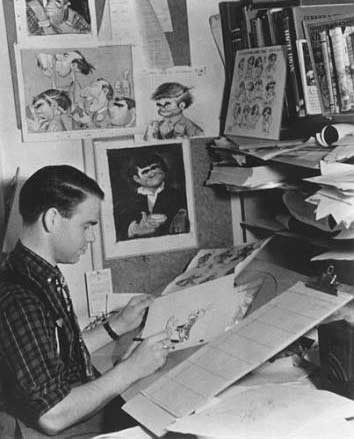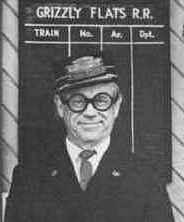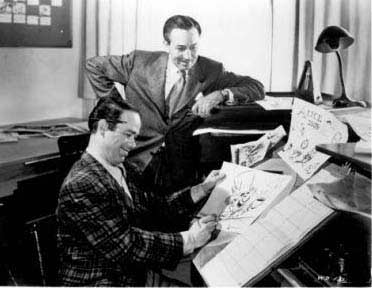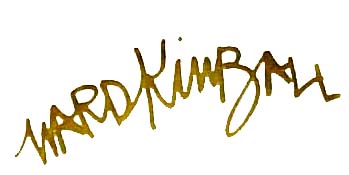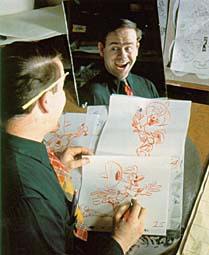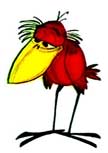

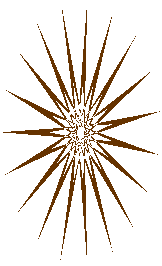
The age of television opened up new possibilities for Disney and a new interest for Kimball. Kimball directed and helped write three "Tomorrowland" themed episodes centering on space travel. The Disneyland episodes included "Man in Space," "Man and the Moon" (both in 1955), and "Mars and Beyond" (in 1957). An "ambassador for space exploration," Kimball was fascinated with the idea of man landing on the moon. Years before his work on television, Kimball appeared as a contestant on Groucho Marx's humorous TV quiz show You Bet Your Life.

Academy Award winning animator Ward Kimball was one of Walt Disney's
Nine Old Men (a team of animators & directors who created the studio's
famous early work). A "modern-day Renaissance man," he was probably the most individual and unique member of the famed group of elite Disney animators -
as his interests and talents stretched far beyond the cartoon world.
... and always let your conscience be your guide!
 | ||||
selected Disney career highlights:
The Tortoise and the Hare (1934) - animator
Snow White and the Seven Dwarfs (1937) - animator
Pinocchio (1940) - animation director
Fantasia (1940) - animation supervisor
The Reluctant Dragon (1941) animator
Dumbo (1941) - animator director
Victory Through Airpower (1943) - animator
Make Mine Music (1946) - animator
Cinderella (1950) - animator
Alice in Wonderland (1951) - directing animator
Toot, Whistle, Plunk and Boom (1953) - director
Man in Space (1956) - director/producer/writer
Dateline: Disneyland (1955) - trombonist of
Firehouse Five Plus Two
Babes In Toyland (1961) - writer
Dad, Can I Borrow the Car? (1970) - producer
Bedknobs and Broomsticks (1971) - animation director
The Mouse Factory (1972) - creator
Mickey Mouse Disco (1979) - animator
World of Motion Epcot Center attraction (1982) - designer/creator
"Ward is one man who works for me I am willing to call a genius" -Walt Disney
THIS SITE MADE IN THE USA
Originally from Minnesota, young Kimball was offered a scholarship to the Santa Barbara School of the Arts in California, after graduating from high school in 1932. During his time at art school, Kimball led a children's band at the Fox Arlington Theatre, where he frequently watched cartoons (he was particularly impressed by Walt Disney's Silly Symphony, The Three Little Pigs). In 1934, he was convinced by an instructor to apply for a job at Disney. He submitted his portfolio at Disney's Hyperion studio ... and was hired on the spot.
Starting out as an inbetweener at Disney (as many rookie animators did) in April 1934, Kimball worked on such shorts as Orphan's Benefit and The Goddess of Spring. He assisted on the Academy Award winning 1935 short The Tortoise and the Hare and soon found himself working on the studio's first full-length feature, Snow White and the Seven Dwarfs. It was around this time that Kimball met a girl from Disney's ink and paint department named Betty Lawyer. By 1936 the two were married (and would remain so until his passing). They had three children - John, Kelly, and Chloe and eventually several grandchildren and great grandchildren!
Now a full-fledged animator, Kimball's work on Disney's next feature accelerated his career to new heights. Kimball created the character of Jiminy Cricket for Pinocchio. The character, which acted as the voice of conscience to the main character, Pinocchio, was said to resemble Kimball in both appearance and mannerisms. He animated the bulk of Jiminy Cricket's scenes, including his speech to Pinocchio in the Pleasure Island pool hall. Kimball's creation still remains one of Disney's most popular and recognized characters.
Animation was just one of Kimball's talents. He was also a jazz trombonist and founding member of the Firehouse Five Plus Two Dixieland jazz group (a band made up of Disney Studio employees). They appeared on television shows, in movies, played live at Disneyland, and recorded a string of albums. (At one point, the group's records actually outsold Dizzy Gillespie on the jazz charts!) The band was even caricatured in the 1953 Goofy short
How to Dance.
As much as Kimball loved music, he also loved trains. Along with his employer and friend Walt Disney, and fellow animator Ollie Johnston, Kimball collected old railroad ephemera. He was such a train enthusiast that he ran his own private railroad on his 3-acre backyard and helped fund the Orange Empire Railway Museum in Perris, California. (In 2005, the Disneyland Railroad named their newly-acquired Engine №5 the "Ward Kimball" in his memory. It even bears a golden silhouette of Jiminy Cricket!)
In 1975 (3 years after his official retirement from Disney), Kimball published two editions of humorous art parodies in a book called Art Afterpieces. He continued to consult on various Disney projects and appear at Disney events throughout his "retirement years." In 1978, Kimball appeared on Tom Snyder’s Tomorrow Show. The interview was shot on location at Grizzly Flats (Kimball's wonderous backyard). In 1989 he (along with the other Nine Old Men and Ub Iwerks) were inducted as Disney Legends. During the span of his career, Kimball won two Academy Awards - one for Toot, Whistle, Plunk, Boom and a second for directing It’s Tough to Be a Bird.
Flamboyant, funny, feisty, and a jack-of-all-trades, Ward Kimball will always be fondly remembered for his vast contributions.
"Becoming an animator is a growth process that involves basic curiosities for all things." -Ward Kimball
 | ||||
It's Tough to Be a Bird (1969)
This Day in Disney History - THE FIRST - THE ORIGINAL
Traveling in time since 1999!


